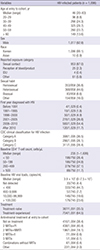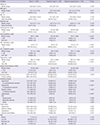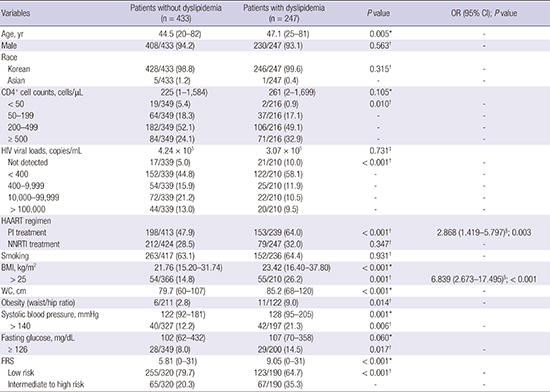1. Casalino E, Wolff M, Ravaud P, Choquet C, Bruneel F, Regnier B. Impact of HAART advent on admission patterns and survival in HIV-infected patients admitted to an intensive care unit. AIDS. 2004; 18:1429–1433.
2. Pau AK, Boyd SD. Recognition and management of significant drug interactions in HIV patients: challenges in using available data to guide therapy. Clin Pharmacol Ther. 2010; 88:712–719.
3. Triant VA, Lee H, Hadigan C, Grinspoon SK. Increased acute myocardial infarction rates and cardiovascular risk factors among patients with human immunodeficiency virus disease. J Clin Endocrinol Metab. 2007; 92:2506–2512.
4. Sobieszczyk ME, Hoover DR, Anastos K, Mulligan K, Tan T, Shi Q, Gao W, Hyman C, Cohen MH, Cole SR, et al. Prevalence and predictors of metabolic syndrome among HIV-infected and HIV-uninfected women in the Women’s Interagency HIV Study. J Acquir Immune Defic Syndr. 2008; 48:272–280.
5. Nguyen KA, Peer N, Mills EJ, Kengne AP. A meta-analysis of the metabolic syndrome prevalence in the global HIV-infected population. PLoS One. 2016; 11:e0150970.
6. Choe YJ, Park SW, Kim HB, Park WB, Lee KD, Oh MD, Choe KW. Metabolic complications in Korean HIV/AIDS patients receiving highly active anti-retroviral therapy. Infect Chemother. 2004; 36:197–206.
7. Choi H, Jeong SJ, Lee HS, Chin BS, Choi SH, Han SH, Kim MS, Kim CO, Choi JY, Song YG, et al. Clinical manifestations for diabetes mellitus in HIV-infected Koreans on highly active antiretroviral therapy. Korean J Med. 2008; 74:506–514.
8. Han SH, Chin BS, Choi HK, Shin SY, Chae YT, Baek JH, Kim CO, Choi JY, Song YG, Lee HC, et al. Prevalence of and clinical factors associated with lipoatrophy in HIV-infected Koreans receiving highly active antiretroviral therapy. Tohoku J Exp Med. 2009; 219:145–153.
9. Han SH, Chin BS, Lee HS, Jeong SJ, Choi HK, Kim CO, Choi JY, Song YG, Lee HC, Kim JM. Serum retinol-binding protein 4 correlates with obesity, insulin resistance, and dyslipidemia in HIV-infected subjects receiving highly active antiretroviral therapy. Metabolism. 2009; 58:1523–1529.
10. Jeong SJ, Chin BS, Chae YT, Jin SJ, Ku NS, Baek JH, Han SH, Kim CO, Choi JY, Song YG, et al. Serum retinol-binding protein-4 levels are increased in HIV-infected subjects with metabolic syndrome receiving highly active antiretroviral therapy. Yonsei Med J. 2012; 53:1211–1215.
11. Kim SB, Kim YC, Kim MH, Song JE, Oh DH, Ahn JY, Ku NS, Kim HW, Jeong SJ, Han SH, et al. A comparison of the predicted risk for cardiovascular disease between HIV-infected and uninfected persons in Korea. Scand J Infect Dis. 2013; 45:855–862.
12. Chobanian AV, Bakris GL, Black HR, Cushman WC, Green LA, Izzo JL Jr, Jones DW, Materson BJ, Oparil S, Wright JT Jr, et al. The seventh report of the joint national committee on prevention, detection, evaluation, and treatment of high blood pressure: the JNC 7 report. JAMA. 2003; 289:2560–2572.
13. American Diabetes Association. Diagnosis and classification of diabetes mellitus. Diabetes Care. 2010; 33:Suppl 1. S62–S69.
14. National Cholesterol Education Program (NCEP) Expert Panel on Detection, Evaluation, and Treatment of High Blood Cholesterol in Adults (Adult Treatment Panel III). Third Report of the National Cholesterol Education Program (NCEP) Expert Panel on Detection, Evaluation, and Treatment of High Blood Cholesterol in Adults (Adult Treatment Panel III) final report. Circulation. 2002; 106:3143–3421.
15. Clinical guidelines on the identification, evaluation, and treatment of overweight and obesity in adults--the evidence report. National Institutes of Health. Obes Res. 1998; 6:Suppl 2. 51S–209S.
16. Screening for lipid disorders in children and adolescents: recommendation statement. Am Fam Physician. 2016; 94:Online.
17. Carr A, Samaras K, Burton S, Law M, Freund J, Chisholm DJ, Cooper DA. A syndrome of peripheral lipodystrophy, hyperlipidaemia and insulin resistance in patients receiving HIV protease inhibitors. AIDS. 1998; 12:F51–F58.
18. D'Agostino RB Sr, Vasan RS, Pencina MJ, Wolf PA, Cobain M, Massaro JM, Kannel WB. General cardiovascular risk profile for use in primary care: the Framingham Heart Study. Circulation. 2008; 117:743–753.
19. Jantarapakde J, Phanuphak N, Chaturawit C, Pengnonyang S, Mathajittiphan P, Takamtha P, Dungjun N, Pinyakorn S, Pima W, Prasithsirikul W, et al. Prevalence of metabolic syndrome among antiretroviral-naive and antiretroviral-experienced HIV-1 infected Thai adults. AIDS Patient Care STDS. 2014; 28:331–340.
20. Gupta V, Biswas A, Sharma SK. Metabolic and body composition changes after six months of highly active antiretroviral therapy in northern Indian patients. Int J STD AIDS. 2011; 22:46–49.
21. Wu PY, Hung CC, Liu WC, Hsieh CY, Sun HY, Lu CL, Wu H, Chien KL. Metabolic syndrome among HIV-infected Taiwanese patients in the era of highly active antiretroviral therapy: prevalence and associated factors. J Antimicrob Chemother. 2012; 67:1001–1009.
22. Ishikawa-Takata K, Ohta T, Moritaki K, Gotou T, Inoue S. Obesity, weight change and risks for hypertension, diabetes and hypercholesterolemia in Japanese men. Eur J Clin Nutr. 2002; 56:601–607.
23. Gazzaruso C, Sacchi P, Garzaniti A, Fratino P, Bruno R, Filice G. Prevalence of metabolic syndrome among HIV patients. Diabetes Care. 2002; 25:1253–1254.
24. Samaras K, Wand H, Law M, Emery S, Cooper D, Carr A. Prevalence of metabolic syndrome in HIV-infected patients receiving highly active antiretroviral therapy using International Diabetes Foundation and Adult Treatment Panel III criteria: associations with insulin resistance, disturbed body fat compartmentalization, elevated C-reactive protein, and [corrected] hypoadiponectinemia. Diabetes Care. 2007; 30:113–119.
25. Wohl D, Scherzer R, Heymsfield S, Simberkoff M, Sidney S, Bacchetti P, Grunfeld C; FRAM Study Investigators. The associations of regional adipose tissue with lipid and lipoprotein levels in HIV-infected men. J Acquir Immune Defic Syndr. 2008; 48:44–52.
26. McComsey GA, Moser C, Currier J, Ribaudo HJ, Paczuski P, Dubé MP, Kelesidis T, Rothenberg J, Stein JH, Brown TT. Body composition changes after initiation of raltegravir or protease inhibitors: ACTG A5260s. Clin Infect Dis. 2016; 62:853–862.
27. Feeney ER, Mallon PW. HIV and HAART-associated dyslipidemia. Open Cardiovasc Med J. 2011; 5:49–63.
28. Kaplan RC, Kingsley LA, Sharrett AR, Li X, Lazar J, Tien PC, Mack WJ, Cohen MH, Jacobson L, Gange SJ. Ten-year predicted coronary heart disease risk in HIV-infected men and women. Clin Infect Dis. 2007; 45:1074–1081.







 PDF
PDF ePub
ePub Citation
Citation Print
Print




 XML Download
XML Download